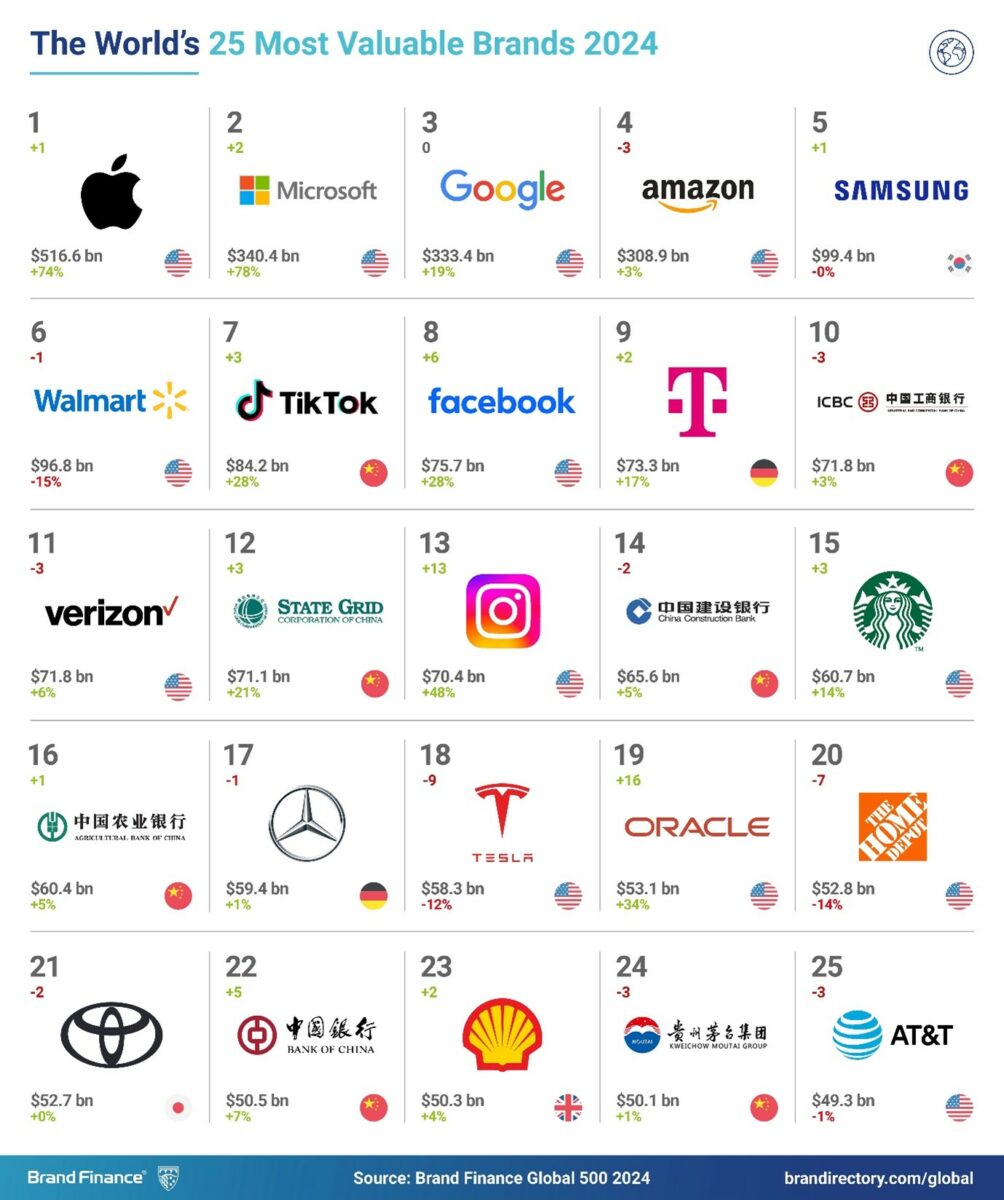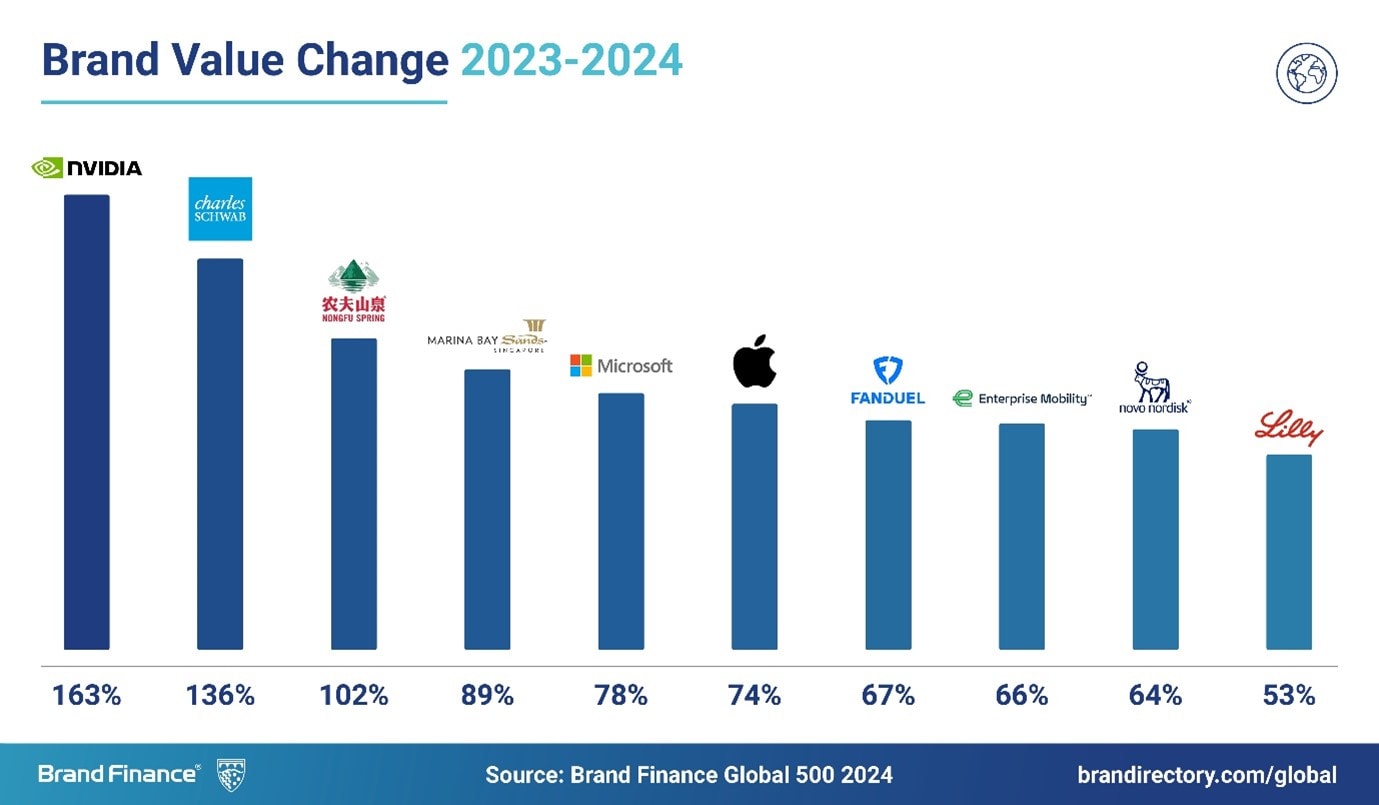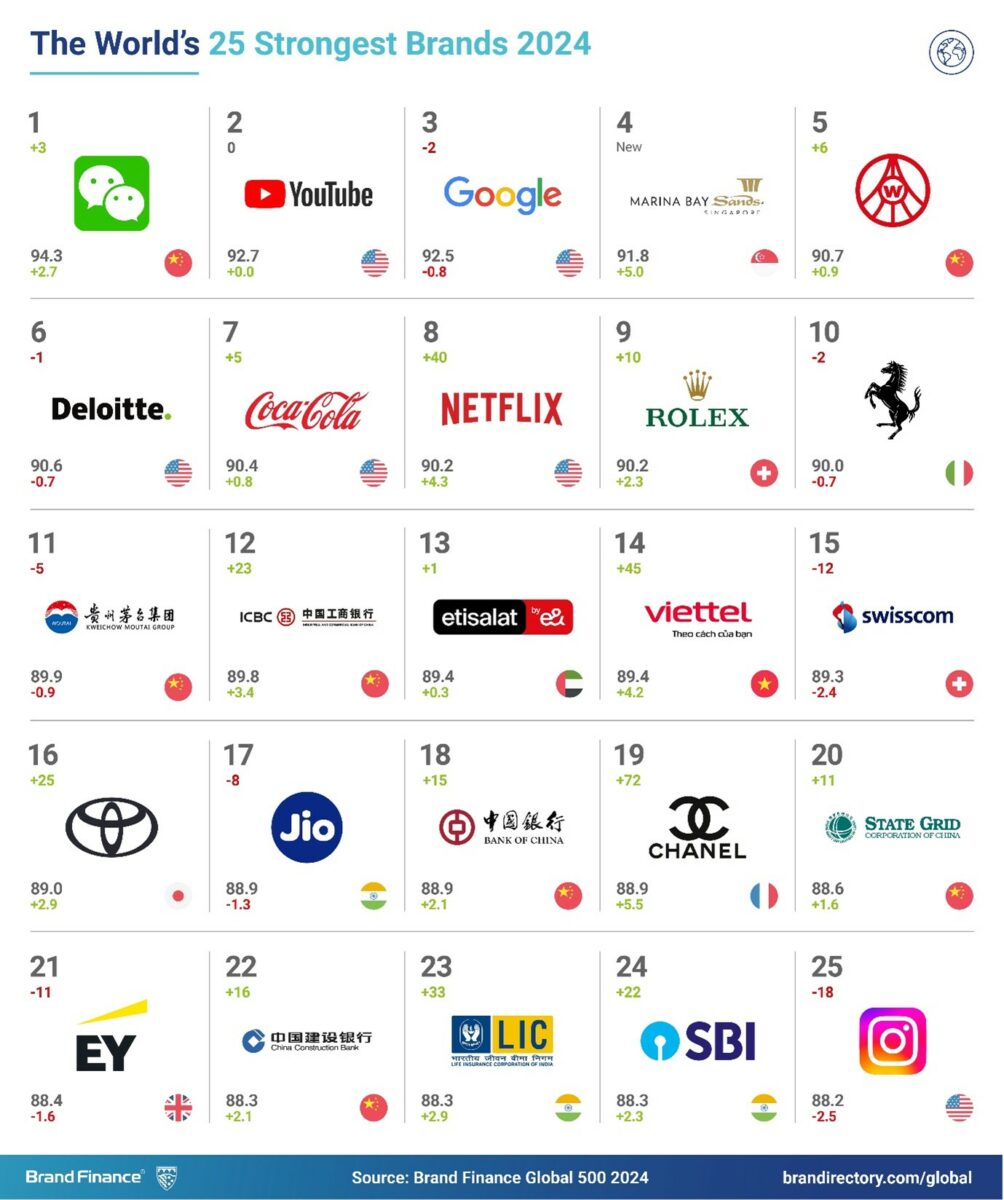View the full Brand Finance Global 500 2024 report here
Seventeen Canadian brands, with a combined brand value of US$155.6 billion, feature in the Brand Finance Global 500 2024 ranking, recording an 11% year-on-year uplift in total brand value.
Every year, leading brand valuation consultancy Brand Finance puts 5,000 of the biggest brands to the test, and publishes over 100 reports, ranking brands across all sectors and countries. The world’s top 500 most valuable and strongest global brands are included in the annual Brand Finance Global 500 2024 ranking.
TD retains its position as the most valuable Canadian brand and is the 100th most valuable brand in the world, with a brand value of USD19.0 billion. Despite having gone from 93 to 100 in Global 500 ranking this year, TD exhibits robust performance in Brand Finance's latest consumer research especially around consideration and familiarity.
TD stands out as the most recognised banking brand in the country, enjoying familiarity from 72% of respondents. 31% of individuals claimed to be currently using TD's services, making it the most preferred banking brand in Canada. This steady market presence speaks to TD's enduring appeal in the industry.
RBC (brand value up 11% to USD16.4 billion) and Canada Life (brand value up 7% to USD11.6 billion) round off the top 3 Canadian brands, sitting in 119th and 178th positions, respectively.
Brookfield is Canada’s fastest-growing brand this year, recording an impressive 29% brand value increase to USD11.5 billion, simultaneously jumping 44 spots in the ranking to 183rd.
Apple has achieved exceptional brand value growth this year, increasing by USD219billion (74%) to USD517 billion, reclaiming its title as the world’s most valuable brand by a huge margin.
Apple has achieved a remarkable brand value increase, even as iPhone volume share has largely plateaued, as its strategy of finding new markets, expanding its ecosystem, and encouraging upgrades to higher-value iPhones has been highly effective. Apple has maintained its position as the dominant player in the premium smartphone market, with 71% value share.
David Haigh, Chairman and CEO of Brand Finance commented:
“Apple has grown its brand value through strategic diversification and premiumisation, moving away from heavy reliance on iPhone sales towards ventures into wearables and services such as Apple TV subscriptions. According to our research, more than 50% of respondents recognised Apple as expensive, but worth the price, reinforcing the brand’s ability to demand a price premium”.

Brand Finance research found significant gain amongst brands that have heavily invested in AI, seeing NVIDIA (brand value up 163% to USD44.5 billion) become the world’s fastest-growing brand. Microsoft (brand value up 78% to USD340.4 billion) has also seen an impressive brand value increase, jumping up two spots to 2nd place.
A key supplier of chips in the AI space, NVIDIA is perceived as highly innovative while familiarity, consideration, and recommendation levels all increased year-on-year, according to Brand Finance research. The brand’s overall performance firmly positions NVIDIA as a front-runner in the AI chip market, demonstrating a successful balance between innovation and market adaptation.

Deutsche Telekom (brand value up 17% to USD73.3 billion) has claimed the title as the world's most valuable telecoms brand, surpassing Verizon (brand value up 6% to USD71.8 billion). Ranked 9th globally, Deutsche Telekom also leads as the most valuable European brand.
Deutsche Telekom’s customer momentum, driven by network strength, has boosted group service revenues, while successful fibre deployment in Europe, alongside 5G leadership in the US, have enhanced connectivity perceptions. Brand Finance research highlights Deutsche Telekom’s leadership in customer satisfaction metrics, driving a Brand Strength Index increase to 83/100. This consistent global brand delivery is reinforced by the introduction of Deutsche Telekom’s unified global claim, "connecting your world," completing its Global Brand Strategy with heightened international focus and customer perspective.

Tesla (brand value down 12% to USD58.3 billion) has dropped out of the top 10, falling to 18th place in the ranking. Tesla has been harmed by its large exposure to the Chinese EV market, and BYD (brand value up 20% to USD12.1 billion) has now overtaken Tesla to become the world’s largest EV maker. While Tesla’s brand strength remains high overall, rated AAA-, Brand Finance research shows a significant fall in reputation. Tesla’s close association with Elon Musk, a controversial leadership figure, creates added reputational risk for the brand.
That said, despite BYD’s greater production volume, Tesla’s brand value is five times that of BYD. This highlights the enduring significance of brands as corporate assets, allowing Tesla to command a price premium, support its company value, and potentially fuel renewed growth.
Brand Finance is launching the Global 500 at Davos on the 17th of January 2024 in partnership with Infosys, the fastest growing IT Services brand over the last 5 years.
View the full Brand Finance Global 500 2024 report here
ENDS
Note to Editors
Every year, leading brand valuation consultancy Brand Finance puts 5,000 of the biggest brands to the test, and publishes over 100 reports, ranking brands across all sectors and countries. The world’s top 500 most valuable and strongest global brands are included in the Brand Finance Global 500 2024 ranking.
Brand value is understood as the net economic benefit that a brand owner would achieve by licensing the brand in the open market. Brand strength is the efficacy of a brand’s performance on intangible measures relative to its competitors.
In addition to calculating brand value, Brand Finance also determines the relative strength of brands through a balanced scorecard of metrics evaluating marketing investment, stakeholder equity, and business performance. Compliant with ISO 20671, Brand Finance’s assessment of stakeholder equity incorporates original market research data from over 150,000 respondents in 41 countries and across 31 sectors.
The full ranking, additional insights, charts, more information about the methodology, and definitions of key terms are available in the Brand Finance Global 500 2024 ranking.
About Brand Finance
Brand Finance is the world’s leading brand valuation consultancy. Bridging the gap between marketing and finance, Brand Finance evaluates the strength of brands and quantifies their financial value to help organisations of all kinds make strategic decisions.
Headquartered in London, Brand Finance has offices in over 20 countries, offering services on all continents. Every year, Brand Finance conducts more than 5,000 brand valuations, supported by original market research, and publishes nearly 100 reports which rank brands across all sectors and countries.
Brand Finance is a regulated accountancy firm, leading the standardisation of the brand valuation industry. Brand Finance was the first to be certified by independent auditors as compliant with both ISO 10668 and ISO 20671, and has received the official endorsement of the Marketing Accountability Standards Board (MASB) in the United States.
Methodology
Definition of Brand
Brand is defined as a marketing-related intangible asset including, but not limited to, names, terms, signs, symbols, logos, and designs, intended to identify goods, services, or entities, creating distinctive images and associations in the minds of stakeholders, thereby generating economic benefits.
Brand Value
Brand value refers to the present value of earnings specifically related to brand reputation. Organisations own and control these earnings by owning trademark rights.
All brand valuation methodologies are essentially trying to identify this, although the approach and assumptions differ. As a result, published brand values can be different.
These differences are similar to the way equity analysts provide business valuations that are different to one another. The only way you find out the “real” value is by looking at what people really pay.
As a result, Brand Finance always incorporates a review of what users of brands actually pay for the use of brands in the form of brand royalty agreements, which are found in more or less every sector in the world.
This is known as the “Royalty Relief” methodology and is by far the most widely used approach for brand valuations since it is grounded in reality.
It is the basis for our public rankings but we always augment it with a real understanding of people’s perceptions and their effects on demand – from our database of market research on over 3000 brands in over 30 markets.
Brand Valuation Methodology
For our rankings, Brand Finance uses the simplest method possible to help readers understand, gain trust in, and actively use brand valuations.
Brand Finance calculates the values of brands in its rankings using the Royalty Relief approach – a brand valuation method compliant with the industry standards set in ISO 10668.
Our Brand Strength Index assessment, a balanced scorecard of brand-related measures, is also compliant with international standards (ISO 20671) and operates as a predictive tool of future brand value changes and a control panel to help business improving marketing.
We do this in the following four steps:
1. Brand Impact
We review what brands already pay in royalty agreements. This is augmented by an analysis of how brands impact profitability in the sector versus generic brands.
This results in a range of possible royalties that could be charged in the sector for brands (for example a range of 0% to 2% of revenue).
2. Brand Strength
We adjust the rate higher or lower for brands by analysing Brand Strength. We analyse brand strength by looking at three core pillars: “Investment” which are activities supporting the future strength of the brand; “Equity” which are real perceptions sourced from our original market research and other data partners; “Performance” which are brand-related measures of business results, such as market share.
Each brand is assigned a Brand Strength Index (BSI) score out of 100, which feeds into the brand value calculation. Based on the score, each brand is assigned a corresponding Brand Rating up to AAA+, in a format similar to a credit rating.
3. Brand Impact x Brand Strength
The BSI score is applied to the royalty range to arrive at a royalty rate. For example, if the royalty range in a sector is 0-5% and a brand has a BSI score of 80 out of 100, then an appropriate royalty rate for the use of this brand in the given sector will be 4%.
4. Brand Value Calculation
We determine brand-specific revenues as a proportion of parent company revenues attributable to the brand in question and forecast those revenues by analysing historic revenues, equity analyst forecasts, and economic growth rates.
We then apply the royalty rate to the forecast revenues to derive brand revenues and apply the relevant valuation assumptions to arrive at a discounted, post-tax present value which equals the brand value.
Disclaimer
Brand Finance has produced this study with an independent and unbiased analysis. The values derived and opinions presented in this study are based on publicly available information and certain assumptions that Brand Finance used where such data was deficient or unclear. Brand Finance accepts no responsibility and will not be liable in the event that the publicly available information relied upon is subsequently found to be inaccurate. The opinions and financial analysis expressed in the study are not to be construed as providing investment or business advice. Brand Finance does not intend the study to be relied upon for any reason and excludes all liability to any body, government, or organisation.
The data presented in this study form part of Brand Finance's proprietary database, are provided for the benefit of the media, and are not to be used in part or in full for any commercial or technical purpose without written permission from Brand Finance.